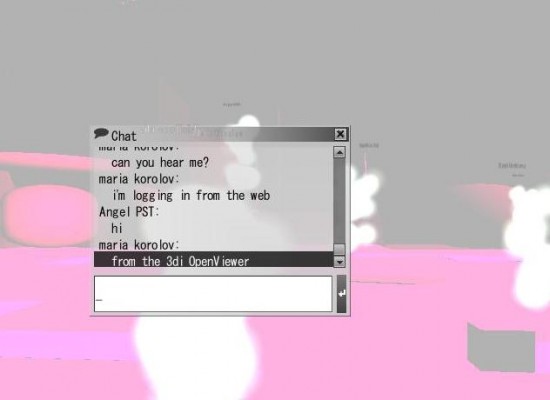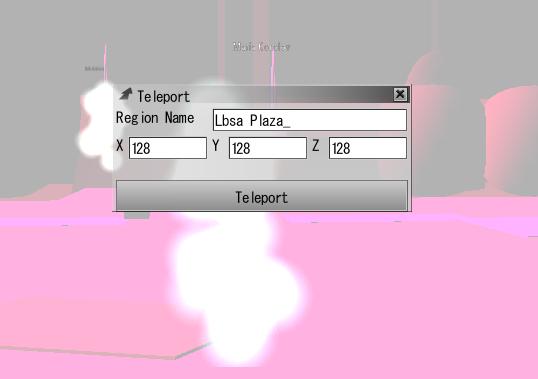A Web-based viewer for OpenSim and Second Life is a Holy Grail for business users: it would make it easier for employees, customers and business partners to access virtual platforms. That would make for easier meetings, easier conferences, easier product demonstrations, easier training seminars, virtual tours, showrooms — all the current applications of virtual worlds that are made difficult by the fact that users have to download a weighty application and spend a couple of hours learning how to use it.
3Di is the first company so far to have come out with a usable Web-based viewer. So far, however, the viewer has only been available in Japanese, and configured to work only with 3Di’s servers for use by their enterprise customers.
But now a version of the viewer is available that will work in English, and allows users to sign into any OpenSim grid. A company can embed the viewer into a website and either sign visitors in with a pre-configured guest account, or allow visitors to use their existing avatars. For behind-the-firewall installations, it will be very straightforward to create a single sign-on process linked to a corporate or student directory.
I installed the viewer using the excellent instructions posted today by Zonja Capalini. I installed the TestPackage on my D: drive, then ran the Firefox install program.
To switch the language from Japanese to English, I followed the instructions from Zaki:
After you start the viewer, the configuration file will be created in your local settings directory. On XP, this will be in Documents and Settings/<username>/Local Settings/Application Data/3Di/OpenViewer/configs/, while on Vista and Win7, this will be in Users/<username>/AppData/LocalLow/3Di/OpenViewer/configs/
Open the file called OpenViewer.ini and change locale to en
locale = en
Start the viewer again and it should be in English now.
Then I opened the index.html file in the InstallPackage folder using Firefox, and entered http://osgrid.org:8002 for my grid, and my OSGrid avatar name and password. It logged me into my previous location on OSGrid.
As expected, the ground was there in full color, and so was the sky, but everything else was plain white.

Navigation was easy and the viewer was very responsive. There was a minimalist set of tools — click on the top right corner of the viewer screen to bring them up. The first is teleport, and I tried teleporting to LBSA Plaza. The viewer froze, and reloading the page crashed the browser.
So from a business use perspective, this viewer is too cumbersome to install, doesn’t display textures, and is unstable. All of these issues are expected to be resolved soon. It’s comforting to know that the 3Di OpenViewer project isn’t just a student project like AjaxLife, or a single guy working in his free time, but has a real company behind it.

After running Firefox again and reloading the viewer, I was able to log in and chat with other avatars on OSGrid’s LBSA Plaza. They could see my avatar fine, but they all appeared as white clouds to me, and all the objects around me were pinkish blobs. I tried hypergrid teleports and got a “region not found” error each time.
“We are working on a fully compatible version that we will release in the future,” said Zaki.

But the potential implications of having this viewer are huge. Not only will viewers like this open up the way towards more general use of OpenSim, but it will also change the way that we design virtual environments.
Today, designers rely to a great degree on the fact that users have logged in using a fully-featured browser. They can use their browsers to edit their appearance, to edit objects, and to interact with other people in rich ways.
With a lightweight viewer such as the 3Di OpenViewer, many of these functions will have to be moved to the server. For example, in order to put on a suit using the Hippo or Meerkat browser, I open my directory folder, search for “suit” and click on it to wear it. With a more light-weight browser, I might teleport to my apartment, go into a closet, and click on a suit hanging inside. The suit would automatically put itself on — and my previous outfit would be hung up in the closet in its place. In other words, the functionality that we currently have in our browsers would be embedded inside objects in the virtual world.
Any number of functions can be moved from a browser to the world. Instead of using a built-in chat function, I can use a virtual telephone to contact my friends coworkers. The advantage of this approach is that I can always get a new phone if someone comes out with a better model — I don’t have to wait for a browser upgrade.
My personal preference as both a business owner and as a user of virtual worlds is to have as many functions as possible running on the server. By moving functions such as chat and inventory out of the browser and into scripted objects it opens up the field to competition and will create a much richer experience for users while simultaneously allowing the world to be accessed from a multitude of devices.
Another implication of the 3Di OpenViewer is that it is an independent, open source project not based on the code in the Second Life browers. Currently, all compatible browsers — including Hippo and Meerkat — have evolved from the Second Life browser, and subject to the same GPL license. The OpenSim server software, however, uses a BSD license, meaning that no developers working on the server code can look at the browser code, and vice versa.
“This is a viewer that does not have a single line of Linden Lab code,” said Zonja Capalini. “The current licensing mess can be completely avoided — which means faster development.”
Related articles:
- OpenSim on the web six months away
- Japan’s 3Di adds voice, web browser to OpenSim
- My Hypergrid Wishlist
- 3DXplorer: an enterprise virtual world with Web access
- 3rd Rock Grid residents find new homes on ZetaWorlds - May 14, 2024
- Five things every grid needs on its home page - May 14, 2024
- International singers gather on Alternate Metaverse Grid for first annual International Day - April 15, 2024
